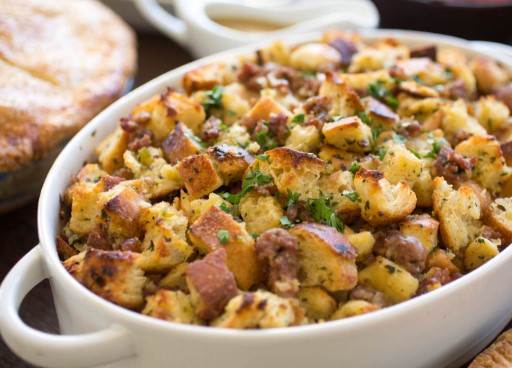Classic Bread Stuffing for Thanksgiving
RECIPE
INGREDIENTS :
Preheat oven to 250°. Butter a 13x9x2-inch baking dish and set aside. Scatter bread in a single layer on a rimmed baking sheet. Bake, stirring occasionally, until dried out, about 1 hour. Let cool; transfer to a very large bowl.
Meanwhile, melt 3/4 cup butter in a large skillet over medium-high heat; add onions and celery. Stir often until just beginning to brown, about 10 minutes. Add to bowl with bread; stir in herbs, salt, and pepper. Drizzle in 1 1/4 cups broth and toss gently. Let cool.
Preheat oven to 350°. Whisk 1 1/4 cups broth and eggs in a small bowl. Add to bread mixture; fold gently until thoroughly combined. Transfer to prepared dish, cover with foil, and bake until an instant-read thermometer inserted into the center of dressing registers 160°, about 40 minutes.
"EVERYTHING YOU WANTED to KNOW ABOUT STUFFING"
But Was Affraid to Ask ?
THE writer Maya Angelou has lived a long life and cooked a lot of turkeys, and one thing she doesn't mince is words.
Stuffing, she says, is really the point of the meal, isn't it?
For Thanksgiving cooks, a perfectly bronzed turkey is a challenge, and mashed sweet potatoes are a comfort, but stuffing is a labor of love.
Whether called stuffing or dressing, made with old crusts of corn bread or French-style pain au levain, moistened with Armagnac or applesauce, this unglamorous, gloriously flavored mixture is the true taste of Thanksgiving for many Americans. A passionate attachment to one's own family recipe, combined with a healthy suspicion of other stuffings, has become part of the holiday ritual.
"I make vats and vats of it, so there will be plenty for seconds and thirds and leftovers," said Susan Ott, an Iowa native who will celebrate Thanksgiving this year in Cornwall, Conn. "And I hate to go to anyone else's house for Thanksgiving, because I fear the stuffing will be weird."
Greg Danford of Burlington, Vt., recalled that "the first time I made oyster stuffing our family matriarch said that she didn't like food with surprises, asked me not to make it again and told me to stick to carving the turkey."
Continue ReadingIn stuffing, as in politics, one American's tradition is another's abomination. Ingredients like oysters, chestnuts, giblets and raisins have long been subjects of fierce debate within families. But dozens of recent interviews with American cooks of all stripes revealed a surprising consensus: although the nation may find itself politically uneasy this Thanksgiving, most people now seem to agree that bread stuffing -- perhaps made with corn bread, probably with onion, possibly a little celery, sage and sausage -- has become the beloved national standard.
There remain, of course, some regional and ethnic variations in stuffing (dressing in the South). Maureen Stein, who grew up in an Irish-French family in the Canadian province of New Brunswick before moving to Queens in 1958, adds boiled potatoes and sarriette, or summer savory, to her recipe. Sheila Clark of Williamsbridge in the Bronx follows the same recipe that her great-grandmother did in Yamacraw Village outside Savannah, Ga., using ground beef, red peppers, onions, apples and raisins. Some Latino families and global-leaning cooks like Orin Herskovitz of Brooklyn use spicy sausages like chorizo or merguez instead of plain pork sausage.
Southern cooks, including Ms. Angelou, are still more likely to use corn bread. Lois Deane of Fayetteville, Ark., who is 91, has followed the same thrifty habit for 70-odd years.
"All year long I put the ends of the corn bread in a plastic sack and keep it in the freezer," she said. "Then at Thanksgiving I mix in some hoecake biscuits and use that for the stuffing."
Ms. Angelou, an Arkansan too, recommends precisely the same ratio of corn bread to white bread as Ms. Deane -- three to one -- to ensure a light mixture. "I think a heavy stuffing makes the turkey feel depressed," she said. Ms. Angelou, whose cookbook, "Hallelujah! The Welcome Table: A Lifetime of Memories With Recipes," has recently been published by Random House, has celebrated Thanksgiving in such far-flung spots as Ghana, Italy and Egypt, but she said she has always managed to make corn bread dressing, even if a turkey to stuff it into has sometimes been unobtainable. (Her stuffing, like the others mentioned here, can be cooked inside or outside the turkey.)
Some Americans, especially New Englanders, add oysters to their stuffing, obstinately following an 18th-century British fashion. Many admitted that they had made it only once, and were then subjected to ridicule and disappointment. But those who love it defend it fiercely. Christina Liao, who lives in Los Angeles, makes a luxurious dressing, almost a bread pudding, with corn bread, heavy cream, eggs, celery, onion and a pint of oysters. "I feel strongly that they add richness and flavor," she said. "My family is Chinese, so we love seafood."
When I tried her recipe on my own family, the response was unanimous: fantastic, except for the oysters. But I am mindful that our own family recipe, made with great ceremony every year by my uncle Julian M. Cohen, would be greeted with horror in many households, as it includes porcini mushrooms, Cognac, raisins and fresh rosemary.
Most cooks interviewed said they are happiest and get the fewest complaints from family and friends around the table when the stuffing they make is close to the classic bread stuffing.
And for new Americans, learning to love this stuffing seems to be part of the process of assimilation. Sasha Armandpour, who grew up in an Iranian family in Laguna Niguel, Calif., said: "The first year I hosted Thanksgiving, I thought it should reflect our heritage, so I stuffed the turkey with saffron rice, apricots and almonds. Everyone hated it. They said Thanksgiving is an American holiday, not an Iranian one."
Carleen Borsella of Park Slope, Brooklyn, whose Italian-American grandmother used to stuff the turkey with a combination of giblets, ricotta and raisins, said she now prefers the bread stuffing from "The Joy of Cooking," having suffered through a Stove Top period of family history.
American couples often have to reconcile competing stuffings as part of the ritual of bonding for the holidays. One Minneapolis woman, who spoke on condition of anonymity to avoid family discord, said she and her husband were so attached to their mothers' stuffing recipes that they had to alternate years at each table. "I hate my mother-in-law's stuffing -- she uses chestnuts -- and when I have to go to her house, I always stop off at my mother's on the way home," she said. "She leaves a container of stuffing in the refrigerator for me, and I eat it in the car."
Brooke Williams of Williamsburg, Brooklyn, whose family stuffing recipe called for pounds of pork sausage, was stumped the first time she had to feed her new husband's relatives, who keep kosher. "I had no idea how to make stuffing without sausage or ham in it," she said. "I had never heard of such a thing."
Out on the stuffing fringes is a tiny minority of Americans who have tried to make Thompson's Turkey, which calls for more than two dozen ingredients in the stuffing alone, including water chestnuts, crushed pineapple, poppy seeds, hot mustard and mace. Devised by Morton Thompson, the author of the 1954 novel "Not as a Stranger" (filmed as a medical melodrama starring Olivia de Havilland, Robert Mitchum and Frank Sinatra), the recipe runs to three single-spaced typed pages, with the stuffing ingredients helpfully divided into Bowl A, Bowl B and Bowl C.
"I got the recipe from my accountant, and I've made it every Thanksgiving for 25 years," said Elizabeth Lewin of Westport, Conn. "You just can't imagine what it's like."
The BADASS COOKBOOK
SECRET RECIPES
RICH CORN BREAD DRESSING
6 1/2 ounces butter (13 tablespoons) 6 cups crumbled corn bread 6 cups torn crusty white bread, such as a baguette 2 cups chopped onion 2 cups chopped celery 1/2 to 1 teaspoon dried sage (optional) 2 teaspoons salt Black pepper 6 eggs, beaten 1 1/2 cups heavy cream 2 cups turkey or chicken broth 2 dozen shucked small oysters, with their liquid (optional).
1. Heat oven to 400 degrees, and butter a 9-by-13-inch baking dish. Melt remaining butter. In a large bowl, combine corn bread, white bread, onion, celery, sage, salt and pepper to taste. Toss until well mixed. Add melted butter, eggs, cream and 1 1/2 cups broth. Toss in oysters, if using. Mix lightly but well; mixture should be very moist. 2. Turn mixture into prepared dish. If mixture seems dry around edges, drizzle on remaining broth. Bake 45 minutes to 1 hour, until firm and browned on top. Yield: 12 servings.
SAUSAGE STUFFING WITH SUMMER SAVORY
2 tablespoons butter
Salt 4 medium-size russet potatoes, peeled
2 tablespoons olive oil
2 medium onions, chopped 2 large stalks celery, chopped 1 pound breakfast pork sausage meat, crumbled 2 cups cubes made from crusty white bread, such as a baguette, toasted
1 cup low-sodium or homemade chicken broth
Pepper 1 to 2 teaspoons dried summer savory.
1. Heat oven to 375 degrees, and butter a 9-by-13-inch baking dish. 2. Boil potatoes in salted water until just cooked through but still firm in center. When cool, cut into 1-inch dice. Set aside. 3. Melt remaining butter and oil together in large skillet over medium heat. Add onions and celery, and cook, stirring, until softened. Reduce heat if necessary to prevent browning. 4. Raise heat to medium-high, add sausage and cook, stirring, using a wooden spoon to break up clumps. When sausage has browned slightly add potatoes, and continue cooking until they are incorporated and slightly browned. Add bread cubes, and mix. 5. Add about half the broth, and mix. If needed, add more to soften bread cubes and to bind the stuffing together. Add salt and pepper to taste, and sprinkle with 1 teaspoon summer savory. Taste, and add more savory if desired. 6. Turn into buttered dish. If mixture seems dry, drizzle on remaining stock. Bake 30 to 40 minutes, until firm and crusty. (The stuffing is even better if mixed in advance, kept refrigerated and baked just before serving.) Yield: 10 to 12 servings.
CORN BREAD Time: 25 minutes
1 tablespoon plus 1/4 cup peanut or corn oil 1 cup coarse yellow cornmeal 1/2 cup all-purpose flour 2 tablespoons sugar 1 teaspoon baking powder 1 teaspoon baking soda 1/2 teaspoon salt 2 eggs 1 cup buttermilk.
1. Heat oven to 425 degrees. Use 1 tablespoon oil to grease 9-inch square or round pan.
2. Combine dry ingredients in one bowl, and whisk wet ingredients in another. Combine, and stir together until batter is just moistened but not smooth. Spread into pan, and bake 15 to 20 minutes, until toothpick inserted in center comes out clean. Cool on rack. Yield: 8 to 10 servings.






No comments:
Post a Comment